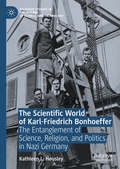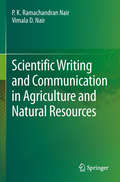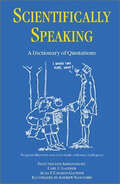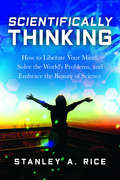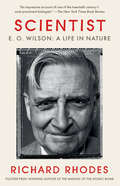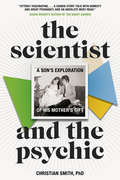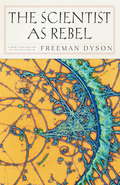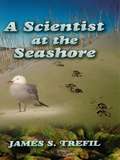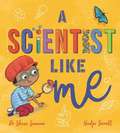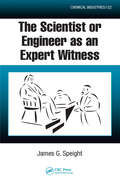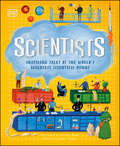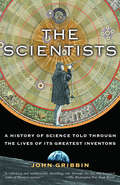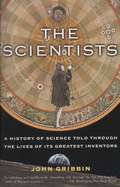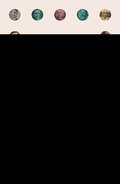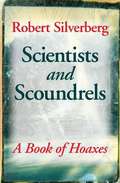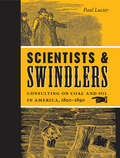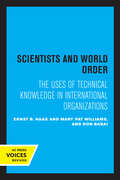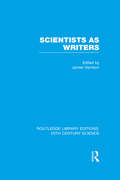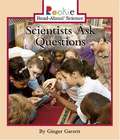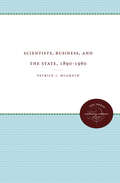- Table View
- List View
The Scientific World of Karl-Friedrich Bonhoeffer: The Entanglement Of Science, Religion, And Politics In Nazi Germany (Palgrave Studies in the History of Science and Technology)
by Kathleen L. HousleyIn twentieth-century Germany, Karl-Friedrich Bonhoeffer rose to prominence as a brilliant physical chemist, even as several of his relatives—Dietrich Bonhoeffer among them—became involved in the resistance to Hitler, leading to their executions. This book traces the entanglement of science, religion, and politics in the Third Reich and in the lives of Karl-Friedrich, his family and his colleagues, including Fritz Haber and Werner Heisenberg. Nominated for the Nobel Prize, Karl-Friedrich was an expert on heavy water, a component of the atomic bomb. During the war, he was caught in the middle between relatives who were trying to kill Hitler and friends who were helping Hitler build a nuclear weapon. Karl-Friedrich emerges as a complex figure—an agnostic whose brother was a renowned theologian, and a chemist who both reluctantly advised German nuclear scientists and collaborated with Paul Rosbaud, a spy for the British. Illuminating the uneasy position of science in twentieth-century Germany, The Scientific World of Karl-Friedrich Bonhoeffer is the story of a man in love with chemistry, his family, and his nation, trying to do right by all of them in the midst of chaos.
Scientific Writing and Communication in Agriculture and Natural Resources
by P.K. Ramachandran Nair Vimala D. NairThe purpose of this book is to help early career professionals in agriculture and natural resources write their research papers for high-quality journals and present their results properly at professional meetings. Different fields have different conventions for writing style such that the authors of the book have found it difficult to recommend to young scientists in these fields a specific book or source material out of the several that are available as the "go to" guide. Writing a scientific paper is a tedious task even to experienced writers; but it is particularly so for the early career professionals such as students, trainees, scientists and scholars in agriculture and natural resources; the challenge is even more when their first language of communication is not English. This book is targeted mainly to that group.
Scientifically Speaking: A Dictionary of Quotations, Second Edition
by C.C. Gaither Alma E Cavazos-GaitherIn these days of ever-increasing specialization, it is important to gain a broad appreciation of science. Entertaining and informative, Scientifically Speaking: A Dictionary of Quotations, Second Edition contains the words and wisdom of several hundred scientists, writers, philosophers, poets, and academics. The largest compilation of published sci
Scientifically Thinking: How to Liberate Your Mind, Solve the World's Problems, and Embrace the Beauty of Science
by Stanley A. RiceShows the many advantages of thinking like a scientist and argues that today's problems require a scientific approach.You don't have to be a scientist to think like a scientist. Anyone can do it and everyone should. This book will show you how. The advantages are many: from detecting bias to avoiding error and appreciating the richness of the world. Author Stanley Rice, himself a scientist, explains that science is essentially organized common sense. While the brain is hardwired for common sense, unfortunately, it also relies on a number of misleading tendencies. Instead of reasoning objectively it tends to rationalize. Often it sees what it wants to see rather than what is really there. And it is adept at both self-deception and deceiving others. Rice notes that these tendencies were useful in the past as the human race evolved in an often-hostile environment. But today bias and delusions put us at risk of worldwide catastrophe.The author invites readers to participate in the adventure of scientific discovery. He provides many interesting and humorous examples of how science works. He shows how hypothesis testing can be used to tackle everyday problems like car trouble or seeing through the specious appeal of a fad diet. Beyond practical applications, science meets the basic human need to satisfy curiosity: it tells verifiable stories about the universe, providing humans with fascinating narratives supported by testable facts. The author also explores some of science's biggest ideas, including natural selection (creating order out of randomness) and interconnectedness (Earth's systems are intricately intertwined). Read this book and learn to think like a scientist. It will guard you against being manipulated by politicians, corporations, and religious leaders, and equip you to deal with the world's most pressing problems. And you will have a lot of fun doing it.
Scientist: E. O. Wilson: A Life in Nature
by Richard RhodesA masterful, timely, fully authorized biography of the great and hugely influential biologist and naturalist E. O. Wilson, one of the most ground-breaking and controversial scientists of our time—from the Pulitzer Prize-winning author of The Making of the Atomic Bomb &“An impressive account of one of the 20th century&’s most prominent biologists, for whom the natural world is &‘a sanctuary and a realm of boundless adventure; the fewer the people in it, the better.&’&” —The New York Times Book ReviewFew biologists in the long history of that science have been as productive, as ground-breaking and as controversial as the Alabama-born Edward Osborne Wilson. At 91 years of age he may be the most eminent American scientist in any field.Fascinated from an early age by the natural world in general and ants in particular, his field work on them and on all social insects has vastly expanded our knowledge of their many species and fascinating ways of being. This work led to his 1975 book Sociobiology, which created an intellectual firestorm from his contention that all animal behavior, including that of humans, is governed by the laws of evolution and genetics. Subsequently Wilson has become a leading voice on the crucial importance to all life of biodiversity and has worked tirelessly to synthesize the fields of science and the humanities in a fruitful way.Richard Rhodes is himself a towering figure in the field of science writing and he has had complete and unfettered access to Wilson, his associates, and his papers in writing this book. The result is one of the most accomplished and anticipated and urgently needed scientific biographies in years.
The Scientist and the Psychic: A Son's Exploration of His Mother's Gift
by Christian SmithWeaving together the story of his fractured relationship to his mother with research into her paranormal abilities, Dr. Christian Smith has created, in The Scientist and the Psychic, a captivating, one-of-a-kind memoir of belief, skepticism and familial love.Christian Smith realized his mother was different in the autumn of 1977 when he was eight years old. Before then, he'd witnessed séances at home and the kids at school sometimes teased him about his mom being a witch--so he sensed that his life wasn't typical. But it wasn't until he was backstage at a renowned concert venue in Toronto, watching from behind a curtain as Geraldine commanded an audience of 2,000 with her extrasensory readings, that he understood she was special. As Geraldine's only child, he would assume the role of the quiet observer while she guided a live CBC broadcast of a séance; made startling and consistently accurate predictions; and eventually moved to LA to work with the parents of murder victims--and with convicted murderer Jeffrey R. MacDonald. Over time, the high profile and emotionally depleting work affected Geraldine's health and relationships. Addiction took over her life, and her son pulled away. Fast forward to the present day: Christian is a molecular biologist and Geraldine is retired and in poor health. They are closer than they've ever been, and now he gives us the story of her undeniable perceptual abilities and pioneering work as a psychic--and endeavours to make scientific sense of it.
The Scientist as Rebel
by Freeman J. DysonFrom Galileo to today's amateur astronomers, scientists have been rebels, writes Freeman J. Dyson. Like artists and poets, they are free spirits who resist the restrictions their cultures impose on them. In their pursuit of nature's truths, they are guided as much by imagination as by reason, and their greatest theories have the uniqueness and beauty of great works of art.Dyson argues that the best way to understand science is by understanding those who practice it. He tells stories of scientists at work, ranging from Isaac Newton's absorption in physics, alchemy, theology, and politics, to Ernest Rutherford's discovery of the structure of the atom, to Albert Einstein's stubborn hostility to the idea of black holes. His descriptions of brilliant physicists like Edward Teller and Richard Feynman are enlivened by his own reminiscences of them. He looks with a skeptical eye at fashionable scientific fads and fantasies, and speculates on the future of climate prediction, genetic engineering, the colonization of space, and the possibility that paranormal phenomena may exist yet not be scientifically verifiable. Dyson also looks beyond particular scientific questions to reflect on broader philosophical issues, such as the limits of reductionism, the morality of strategic bombing and nuclear weapons, the preservation of the environment, and the relationship between science and religion. These essays, by a distinguished physicist who is also a prolific writer, offer informed insights into the history of science and fresh perspectives on contentious current debates about science, ethics, and faith.
A Scientist at the Seashore
by James S. Trefil"A marvelous excursion from the beach to the ends of the solar system . . . captivating."--The New York Times"So easy to understand yet so dense with knowledge that you'll never look at waves on a beach the same way again."--San Francisco Chronicle"One of the best popular science books."--The Kansas City Star"Perfect for the weekend scientist."--The Richmond News-LeaderA noted physicist and popular science writer heads for the beach to answer common and uncommon questions about the ocean. James S. Trefil, author of Dover Publications' The Moment of Creation: Big Bang Physics from Before the First Millisecond to the Present Universe, explains why the sea is salty, how bubbles form on the water's surface, where waves come from, and other curiosities of the marine world. Dr. Trefil draws upon his unique gift for clarifying complex scientific principles and the theories behind them to present a narrative that is clear, accessible, and utterly compelling.
A Scientist Like Me
by Dr Shini SomaraElectrifying illustrations and an empowering story combine to introduce young readers to the world of science, observation and problem-solving.There's NOTHING that Ruben doesn't find fascinating. Why do leaves change colour? What makes ice cream melt? On a trip to the beach with his mum, he discovers how the world works and the brilliant scientists who have helped us understand it. Maybe he can try out some awesome experiments and become a scientist too?With pages encouraging kids to try out their very own science experiments such as germinating seeds and writing with invisible ink, this brilliant picture book written by scientist and TV presenter Dr Shini Somara unlocks a love of science and celebrates women in STEM.The second book in an exciting new series. Also available:- An Engineer Like Me- A Coder Like Me- A Mathematician Like Me
The Scientist or Engineer as an Expert Witness (Chemical Industries)
by James G SpeightThe increased technical nature of litigation coupled with an increase in the number of cases have given rise to the need for a book specifically written for scientists and engineers called to testify as expert witnesses. Unique in its approach, The Scientist or Engineer as an Expert Witness assists these experts in clearly conveying the often compl
Scientist, Scientist, Who Do You See?
by Chris Ferrie<p>A scientific twist on a beloved children's classic that's sure to delight both parent and child! <p>Scientist, Scientist, Who do you see? I see Marie Curie in her laboratory! <p>The adored children's classic Brown Bear, Brown Bear gets a nerdy makeover in this picture book by the #1 bestselling science author for kids! Young readers will delight at taking a familiar text and poking fun at it all while learning about scientists and how they changed the world. Back matter includes brief biographical information of the featured scientists. This sweet parody is the perfect inspiration for scientists of all ages! <p>Full of scientific rhyming fun, Scientist, Scientist, Who Do You See? features appearances by some of the world's greatest scientists! From Albert Einstein to Marie Curie and Ahmed Zewail, from Charles Darwin to Chien-Shiung Wu and Grace Hopper... and more!</p>
Scientists: Inspiring Tales of the World's Brightest Scientific Minds (DK Explorers)
by DKMeet the people who changed the world of science and technology, biology, chemistry and physics!Read the stories of the brainiest people who ever lived and the scientific discoveries they made. Each page illustrates a famous scientist's life and what made their contribution to this fascinating field so important. Scientists is an exciting book perfect for children ages 7-9 years. Inside you will find: • Stories of more than 50 scientists like Isaac Newton, both famous and lesser-known. • Comprehensive coverage of the most important scientific advancements of all time. • Stories of scientists from all over the world specializing in different areas of science. • Information inline with the STEAM and STREAM school curriculums. Introduce children to titans of science!The biggest scientific breakthroughs in history have something in common: super smart people who kept looking for the answers to some of the world&’s most interesting questions! The pages of this science book are filled with the stories of famous scientists like physicists Neil DeGrasse Tyson and Stephen Hawking, biologist Marie Curie, paleontologist Mary Anning, and lesser-known trailblazers like Chika Kuroda, who became Japan's first female Bachelor of Science.Filled with great detail and following a storytelling format, this is a thrilling book that will capture the imagination of young children and encourage them to explore the world of science. Beautiful descriptions of the scientists' lives are brought to life through stunning watercolor illustrations, and fantastic photography highlights the detail of their discoveries.Discover more stories!Follow the stories of some of the greatest people the world has ever known. DK&’s Scientist, Explorers, and Inventors captures the genius of people who have changed history, answered important questions and made our lives easier.
The Scientists: A History of Science Told Through the Lives of Its Greatest Inventors (Britannica Guides)
by John GribbinA wonderfully readable account of scientific development over the past five hundred years, focusing on the lives and achievements of individual scientists, by the bestselling author of In Search of Schrödinger’s CatIn this ambitious new book, John Gribbin tells the stories of the people who have made science, and of the times in which they lived and worked. He begins with Copernicus, during the Renaissance, when science replaced mysticism as a means of explaining the workings of the world, and he continues through the centuries, creating an unbroken genealogy of not only the greatest but also the more obscure names of Western science, a dot-to-dot line linking amateur to genius, and accidental discovery to brilliant deduction.By focusing on the scientists themselves, Gribbin has written an anecdotal narrative enlivened with stories of personal drama, success and failure. A bestselling science writer with an international reputation, Gribbin is among the few authors who could even attempt a work of this magnitude. Praised as “a sequence of witty, information-packed tales” and “a terrific read” by The Times upon its recent British publication, The Scientists breathes new life into such venerable icons as Galileo, Isaac Newton, Albert Einstein and Linus Pauling, as well as lesser lights whose stories have been undeservedly neglected. Filled with pioneers, visionaries, eccentrics and madmen, this is the history of science as it has never been told before.
The Scientists: A History of Science Told Through the Lives of Its Greatest Inventors
by John GribbinA wonderfully readable account of scientific development over the past five hundred years, focusing on the lives and achievements of individual scientists, by the bestselling author of In Search of Schrödinger's Cat. In this ambitious new book, John Gribbin tells the stories of the people who have made science, and of the times in which they lived and worked. He begins with Copernicus, during the Renaissance, when science replaced mysticism as a means of explaining the workings of the world, and he continues through the centuries, creating an unbroken genealogy of not only the greatest but also the more obscure names of Western science, a dot-to-dot line linking amateur to genius, and accidental discovery to brilliant deduction. By focusing on the scientists themselves, Gribbin has written an anecdotal narrative enlivened with stories of personal drama, success and failure. A bestselling science writer with an international reputation, Gribbin is among the few authors who could even attempt a work of this magnitude. Praised as "a sequence of witty, information-packed tales" and "a terrific read" by The Times upon its recent British publication, The Scientists breathes new life into such venerable icons as Galileo, Isaac Newton, Albert Einstein and Linus Pauling, as well as lesser lights whose stories have been undeservedly neglected. Filled with pioneers, visionaries, eccentrics and madmen, this is the history of science as it has never been told before.
The Scientists: An Epic Of Discovery
by Andrew RobinsonAn intriguing and illuminating read for science buffs, those fascinated by the lives and minds of great men and women, and anyone curious about how we came to understand the physical world The ideas, experiments, and inventions of great scientists have revolutionized our understanding of the world around us. Theories, discoveries, and technologies—from relativity, the genetic code, and the periodic table to synthetic drugs, nuclear weapons, and brain scans—have transformed the physical world and our lives. Copernicus, Crick, Watson, Galileo, Marie Curie: these are some of the forty pioneers behind modern science whose stories are explored here. The scientists come from around the globe and represent multiple nationalities—American, English, German, French, Dutch, Czech, Indian, Japanese, and more. Often unorthodox thinkers, they frequently had to struggle against hostile contemporaries to gain recognition for their ideas and discoveries. All the major scientific disciplines are covered, including astronomy, biology, biochemistry, chemistry, computing, ecology, geology, medicine, neurology, physics, and psychology, as well as mathematics.
Scientists and Scoundrels: A Book of Hoaxes
by Robert SilverbergAs if history and nature had not provided wonders enough, through the ages humans themselves have contrived more marvels to deceive one another. Sometimes they have concocted evidence when none was available to prove pet theories; sometimes their intention has been to impress or defraud; sometimes they have acted merely for sport. Robert Silverberg tells the stories of a baker's dozen of these scientific hoaxers in a lively, good-humored book that ranges through time and across continents. Here are perpetual-motion machines and space rockets, men on the moon and serpents in the sea. The rogues' gallery is a varied one: Dr. Mesmer, who cast his hypnotic spell on eighteenth-century Paris; Charles Dawson, whose Piltdown Man challenged evolution; Dr. Cook, with his tale of "discovering" the North Pole; and many others. These are fascinating stories and more than just entertainment. The author explains the scientific background against which the hoaxes appeared and the detective work that led to their exposure. The schemers teach us to be alert, to challenge the evidence, and to appreciate the healthy skepticism that characterizes the scientific method.
Scientists and Swindlers: Consulting on Coal and Oil in America, 1820–1890 (Johns Hopkins Studies in the History of Technology)
by Paul LucierIn this impressively researched and highly original work, Paul Lucier explains how science became an integral part of American technology and industry in the nineteenth century. Scientists and Swindlers introduces us to a new service of professionals: the consulting scientists. Lucier follows these entrepreneurial men of science on their wide-ranging commercial engagements from the shores of Nova Scotia to the coast of California and shows how their innovative work fueled the rapid growth of the American coal and oil industries and the rise of American geology and chemistry. Along the way, he explores the decisive battles over expertise and authority, the high-stakes court cases over patenting research, the intriguing and often humorous exploits of swindlers, and the profound ethical challenges of doing science for money.Starting with the small surveying businesses of the 1830s and reaching to the origins of applied science in the 1880s, Lucier recounts the complex and curious relations that evolved as geologists, chemists, capitalists, and politicians worked to establish scientific research as a legitimate, regularly compensated, and respected enterprise. This sweeping narrative enriches our understanding of how the rocks beneath our feet became invaluable resources for science, technology, and industry.
Scientists and Swindlers: Consulting on Coal and Oil in America, 1820–1890 (Johns Hopkins Studies in the History of Technology)
by Paul LucierAn “insightful” account of the early fossil fuel industry, the rise of the professional consultant, and the nexus between science and money (Technology and Culture).In this impressively researched, highly original work, Paul Lucier explains how science became an integral part of American technology and industry in the nineteenth century. Scientists and Swindlers introduces us to a new service of professionals: the consulting scientists. Lucier follows these entrepreneurial men of science on their wide-ranging commercial engagements from the shores of Nova Scotia to the coast of California and shows how their innovative work fueled the rapid growth of the American coal and oil industries and the rise of American geology and chemistry. Along the way, he explores the decisive battles over expertise and authority, the high-stakes court cases over patenting research, the intriguing and often humorous exploits of swindlers, and the profound ethical challenges of doing science for money. Starting with the small surveying businesses of the 1830s and reaching to the origins of applied science in the 1880s, Lucier recounts the complex and curious relations that evolved as geologists, chemists, capitalists, and politicians worked to establish scientific research as a legitimate, regularly compensated, and respected enterprise. This sweeping narrative enriches our understanding of how the rocks beneath our feet became invaluable resources for science, technology, and industry.
Scientists and World Order: The Uses of Technical Knowledge in International Organizations
by Ernst B. Haas Mary Pat Williams Don BabaiThis title is part of UC Press's Voices Revived program, which commemorates University of California Press’s mission to seek out and cultivate the brightest minds and give them voice, reach, and impact. Drawing on a backlist dating to 1893, Voices Revived makes high-quality, peer-reviewed scholarship accessible once again using print-on-demand technology. This title was originally published in 1977.
Scientists as Writers (Routledge Library Editions: 20th Century Science)
by James HarrisonIn the endless debate about the Two Cultures no book until this attempted to provide a selection of scientific writing on specific themes to stimulate students of arts subjects into discussion and writing about the nature of science and its relationship with the rest of life. This book is based on a selection of prose passages written by scientists about science, supplemented by notes and a brief linking commentary. Originally published in 1965, the passages were chosen to illustrate or comment on different aspects of eleven main themes, ranging from surveys of changing ideas on the nature of the universe and the material of which it was made, to evolution past and future and the relation of science with religion and art. Most of the extracts were from contemporary authors, but there are passages by Aristotle, Bacon, Boyle, Hooke, Newton, Dalton, Faraday and Darwin. At the end of the book there are suggestions for discussion to accompany each chapter, to encourage the study of the use of language in consideration of the nature, history and role of science.
Scientists Ask Questions (Fountas & Pinnell LLI Blue #Level K)
by Ginger GarrettA simple introduction to scientific investigation, describing what it is and giving examples of how scientists use tools and conduct experiments.
Scientists at War
by Sarah BridgerSarah Bridger examines the ethical debates that tested the U.S. scientific community during the Cold War, and scientists' contributions to military technologies and strategic policymaking, from the dawning atomic age through the Strategic Defense Initiative (Star Wars) in the 1980s, which sparked cross-generational opposition among scientists.
Scientists, Business, and the State, 1890-1960 (The Luther H. Hodges Jr. and Luther H. Hodges Sr. Series on Business, Entrepreneurship, and Public Policy)
by Patrick J. McGrathIn the late nineteenth century, scientists began allying themselves with America's corporate, political, and military elites. They did so not just to improve their professional standing and win more money for research, says Patrick McGrath, but for political reasons as well. They wanted to use their new institutional connections to effect a transformation of American political culture. They succeeded, but not in ways that all scientists envisioned or agreed upon. McGrath describes how, between 1890 and 1960, scientific, business, and political leaders together forged a new definition of American democracy in which science and technology were presented to the public as crucial ingredients of the nation's progress, prosperity, and political stability. But as scientists became more prominent, they provoked conflicts among themselves as well as with their institutional patrons over exactly how their expertise should be used. McGrath examines the bitter battles that erupted over the role scientists should play during the Great Depression, World War II, the Cold War arms race, and the security and loyalty investigations of the 1950s. He finds that, by the end of the 1950s, scientists were regarded by the political and military elite not as partners but as subordinate technicians who were expected to supply weapons on demand for the Cold War state.Originally published 2001.A UNC Press Enduring Edition -- UNC Press Enduring Editions use the latest in digital technology to make available again books from our distinguished backlist that were previously out of print. These editions are published unaltered from the original, and are presented in affordable paperback formats, bringing readers both historical and cultural value.
